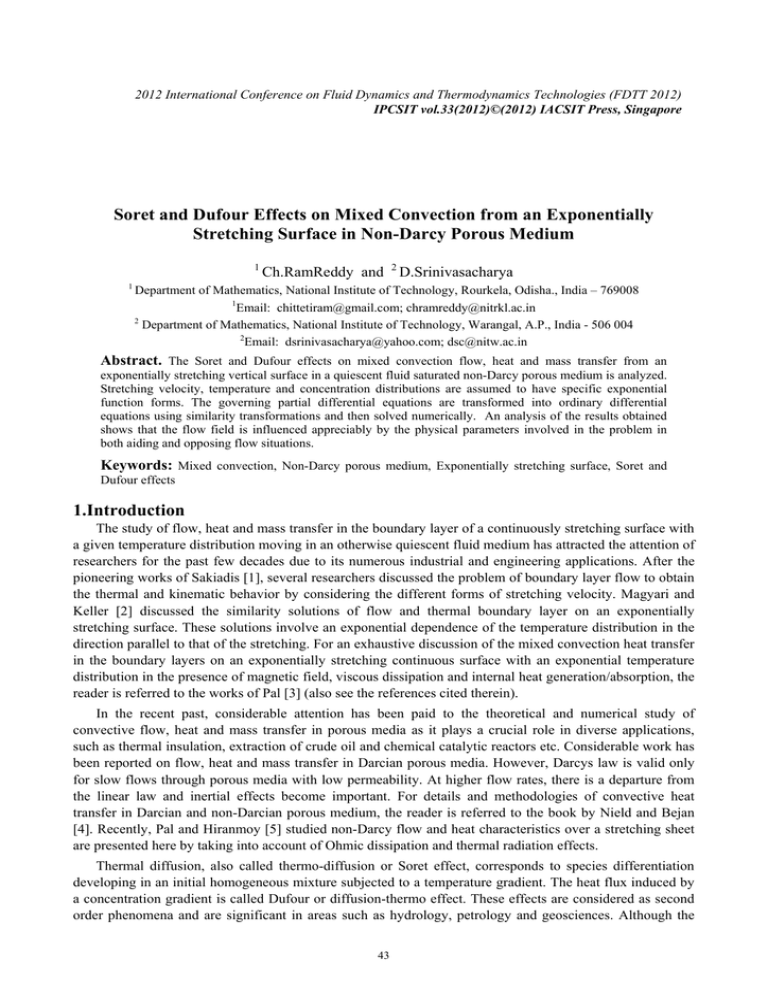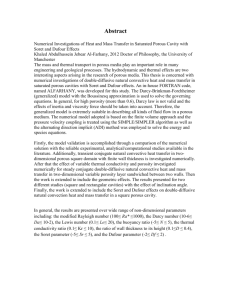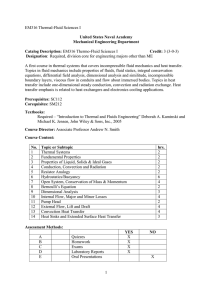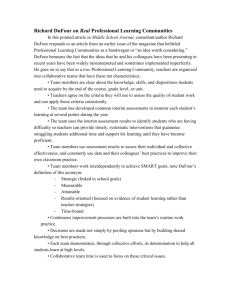Soret and Dufour Effects on Mixed Convection from an Exponentially
advertisement

2012 International Conference on Fluid Dynamics and Thermodynamics Technologies (FDTT 2012) IPCSIT vol.33(2012)©(2012) IACSIT Press, Singapore Soret and Dufour Effects on Mixed Convection from an Exponentially Stretching Surface in Non-Darcy Porous Medium 1 1 Ch.RamReddy and 2 D.Srinivasacharya Department of Mathematics, National Institute of Technology, Rourkela, Odisha., India – 769008 1 Email: chittetiram@gmail.com; chramreddy@nitrkl.ac.in 2 Department of Mathematics, National Institute of Technology, Warangal, A.P., India - 506 004 2 Email: dsrinivasacharya@yahoo.com; dsc@nitw.ac.in Abstract. The Soret and Dufour effects on mixed convection flow, heat and mass transfer from an exponentially stretching vertical surface in a quiescent fluid saturated non-Darcy porous medium is analyzed. Stretching velocity, temperature and concentration distributions are assumed to have specific exponential function forms. The governing partial differential equations are transformed into ordinary differential equations using similarity transformations and then solved numerically. An analysis of the results obtained shows that the flow field is influenced appreciably by the physical parameters involved in the problem in both aiding and opposing flow situations. Keywords: Mixed convection, Non-Darcy porous medium, Exponentially stretching surface, Soret and Dufour effects 1.Introduction The study of flow, heat and mass transfer in the boundary layer of a continuously stretching surface with a given temperature distribution moving in an otherwise quiescent fluid medium has attracted the attention of researchers for the past few decades due to its numerous industrial and engineering applications. After the pioneering works of Sakiadis [1], several researchers discussed the problem of boundary layer flow to obtain the thermal and kinematic behavior by considering the different forms of stretching velocity. Magyari and Keller [2] discussed the similarity solutions of flow and thermal boundary layer on an exponentially stretching surface. These solutions involve an exponential dependence of the temperature distribution in the direction parallel to that of the stretching. For an exhaustive discussion of the mixed convection heat transfer in the boundary layers on an exponentially stretching continuous surface with an exponential temperature distribution in the presence of magnetic field, viscous dissipation and internal heat generation/absorption, the reader is referred to the works of Pal [3] (also see the references cited therein). In the recent past, considerable attention has been paid to the theoretical and numerical study of convective flow, heat and mass transfer in porous media as it plays a crucial role in diverse applications, such as thermal insulation, extraction of crude oil and chemical catalytic reactors etc. Considerable work has been reported on flow, heat and mass transfer in Darcian porous media. However, Darcys law is valid only for slow flows through porous media with low permeability. At higher flow rates, there is a departure from the linear law and inertial effects become important. For details and methodologies of convective heat transfer in Darcian and non-Darcian porous medium, the reader is referred to the book by Nield and Bejan [4]. Recently, Pal and Hiranmoy [5] studied non-Darcy flow and heat characteristics over a stretching sheet are presented here by taking into account of Ohmic dissipation and thermal radiation effects. Thermal diffusion, also called thermo-diffusion or Soret effect, corresponds to species differentiation developing in an initial homogeneous mixture subjected to a temperature gradient. The heat flux induced by a concentration gradient is called Dufour or diffusion-thermo effect. These effects are considered as second order phenomena and are significant in areas such as hydrology, petrology and geosciences. Although the 43 Soret and Dufour effects of the medium on the heat and mass transfer in a viscous fluid are important, very little work has been reported in the literature. The importance of these effects in convective transport in clear fluids has been reported in the book by Eckert and Drake [6]. Dursunkaya and Worek [7] analyzed diffusionthermo and thermal-diffusion effects in transient and steady natural convection from a vertical surface, whereas Kafoussias and Williams [8] presented the same effects on mixed convective and mass transfer steady laminar boundary layer flow over a vertical flat plate with temperature dependent viscosity. Ahmed [9] considered free convective heat and mass transfer of an incompressible, electrically conducting fluid over a stretching sheet in the presence of suction and injection with thermal-diffusion and diffusion-thermo effects. A mathematical model for the steady mixed convection heat and mass transfer in a viscous as well as micropolar fluid in the presence of significant Dufour and Soret effects with different surface conditions is presented by Srinivasacharya and RamReddy ([10],[11]). Thus motivated by the above investigations and applications mentioned, the purpose of the present work is to investigate the Soret and Dufour effects on mixed convection heat and mass transfer from an exponentially stretching surface in a viscous fluid saturated non-Darcy porous medium. 2. Mathematical Formulation Consider a steady, two-dimensional and laminar flow of an incompressible viscous fluid near an impermeable plane vertical wall stretching with velocity u w (x) , heat flux q w (x) and mass flux q m (x) moving through a quiescent incompressible fluid of constant temperature T∞ and concentration C ∞ . The x-axis is directed along the continuous stretching surface and points in the direction of motion and y-axis is perpendicular to it. Assume that the fluid and the porous medium have constant physical properties. The fluid flow is moderate and the permeability of the medium is low so that the Forchheimer flow model is applicable and the boundary effect is neglected. The fluid and the porous medium are in local thermodynamical equilibrium. Assuming that the Boussinesq and boundary-layer approximations hold and using the DarcyForchheimer model and Dupuit-Forchheimer relationship [4], the governing equations for the viscous fluid saturated non-Darcy porous medium in the presence of Soret and Dufour effects [8] are given by ∂u ∂v + = 0 ∂x ∂y (1) 1 ⎛ ∂u ∂u ⎞ ν ∂2u * ν b 2 ⎜ ⎟ ( ( ) ( ) ) u v + = g β T T β C C u u + − + − − − ∞ ∞ T C KP KP ε 2 ⎜⎝ ∂x ∂y ⎟⎠ ε ∂y 2 (2) u ∂T ∂T ∂ 2T DKT ∂ 2C +v =α + ∂x ∂y ∂y 2 CS C P ∂y 2 (3) u ∂C ∂C ∂ 2C DKT ∂ 2T +v =D + ∂x ∂y ∂y 2 Tm ∂y 2 (4) where u and v are the velocity components in x and y directions respectively, T is the temperature, C is the concentration, g* is the acceleration due to gravity, ρ is the density, ν is the kinematic viscosity, μ is the dynamic coefficient of viscosity, b is the Forchheimer constant, K P is the permeability, ε is the porosity, β T is the coefficient of thermal expansion, β C is the coefficient of solutal expansions, α is the thermal diffusivity, D is the solutal diffusivity of the medium, C P is the specific heat capacity, C S is the concentration susceptibility, Tm is the mean fluid temperature and K T is the thermal diffusion ratio. The last term on the right-hand side of the energy equation (3) and diffusion equation (4) signifies the Dufour or diffusion-thermo effect and the Soret or thermal-diffusion effect, respectively. The boundary conditions are 44 x x ⎛ ∂T ⎞ ⎛ ∂C ⎞ ⎟⎟ = qwe L , − D⎜⎜ ⎟⎟ = qm e L u = u w ( x), v = 0, − k ⎜⎜ ⎝ ∂ y ⎠w ⎝ ∂ y ⎠w u = 0, T = T∞ , C = C∞ as y→∞ y=0 at (5a) (5b) where the subscripts w and ∞ indicate the conditions at the wall and at the outer edge of the boundary layer respectively, q w and q m are parameters of the temperature concentration distribution in the stretching surface. x u w ( x) = u0e L , where u0 is velocity parameter of the The stretching velocity u w (x) is defined as stretching surface. In view of the continuity equation (1), defining the stream function ψ such that u= ∂ψ ∂ψ , v =− ∂y ∂x (7) Substituting (7) in (2)-(4) and then using the following local similarity transformations x 1 Re y x 2 L ⎫ η= e , ψ = 2 ν Re 2 e 2 L f (η ) ⎪⎪ 2 L ⎬ 2qw L −12 x 2 L 2qm L −12 x 2 L T ( x, y ) = T∞ + Re e θ (η ), C ( x, y ) = C∞ + Re e φ (η )⎪ ⎪⎭ k k (8) the governing equations become 1 ε f ' ' '+ 1 ε 2 (f ) f ' '−2 f ' 2 + 2 Ri e −3 X / 2 (θ + B φ ) − 2 2.Fs 2 e − X f '− f' =0 Da. Re Da 1 θ ' '+ f θ '− f 'θ + D f φ ' ' = 0 Pr 1 φ ' '+ f φ '− f 'φ + S rθ ' ' = 0 Sc (9) (10) (11) where the primes indicate partial differentiation with respect to η alone, L is the characteristic length of the g * βT qw L4 uL x is the X-location, Gr = is the thermal Grashof number, Re = 0 is the 2 L kν ν K b β q k Reynolds number, Da = 2P is the Darcy number, Fs = is the Forchheimer number, Β = C m is the βT qw D L L D K T qm k ν ν is the Prandtl number, Sc = is the Schmidt number, D f = is buoyancy ratio, Pr = α D C S C Pν q w D DK q D Gr T w is the Soret number. Ri = is the mixed convection the Dufour number and S = 5 r 2 νT q k Re m m plate, X = parameter, is the mixed convection parameter, which represents the ratio of buoyancy forces to the inertia forces and is used to delineate the free, forced and mixed convection regimes. When Ri = 0, the flow becomes a forced convection flow and when Ri is large, the flow become free convection flow. Boundary conditions (5) in terms of f, θ and φ become η = 0 : f = 0, f ' = 1, θ ' = −1, φ ' = −1 η → ∞ : f ' = 0, θ = 0, φ = 0 (12a) (12b) A close look at Eq.(9) reveals that, in mixed convection due to viscous fluid, the velocity profile are not similar because the x-coordinate cannot be eliminated from this equation. Thus, for ease of analysis, it 45 was decided to proceed with finding local similarity solutions for the governing equations by taking X = x L and studied the effects of various parameters on different profiles at any given X-location. The non-dimensional skin friction C f = x qw ( x ) 2τ w , the local Nusselt number Nu x = 2 ρ U* k (Tw ( x) − T∞ ( x) ) x qm ( x ) where U* is the characteristic velocity, are given by D(Cw ( x) − C∞ ( x) ) Nu x Sh x X XL 1 X XL 1 = = Re x = 2 X f ' ' (0) , e and e . φ (0) θ (0) Re x 2 Re x 2 and local Sherwood number Shx = Cf where Re x = u w ( x) x ν is the local Reynolds number. 3. Results and Discussions The system of non-linear ordinary differential equations (9)- (11) together with the boundary conditions (12) are locally similar and solved numerically using Keller-box implicit method discussed in book by Cebecci and Bradshow [12]. In the present study we have adopted the following default parameter values for the numerical computations: Pr = 1.0, Sc = 0.22, B = 0.5 and the maximal value of η at ∞ is 15.These values are used throughout the computations, unless otherwise indicated. Table 1: Effects of skin friction, heat and mass transfer coefficients for varying values of Ri, Fs, Da, S r , D f and X . Ri Fs Da Sr Df X f ' ' (0) -0.5 -0.1 0.5 3.0 5.0 1.0 1.0 1.0 1.0 1.0 1.0 1.0 1.0 1.0 1.0 1.0 1.0 1.0 1.0 1.0 1.0 1.0 1.0 1.0 1.0 0.5 0.5 0.5 0.5 0.5 0.0 0.3 0.7 1.0 0.5 0.5 0.5 0.5 0.5 0.5 0.5 0.5 0.5 0.5 0.5 0.5 0.5 0.5 0.5 0.5 0.1 0.1 0.1 0.1 0.1 0.1 0.1 0.1 0.1 0.01 0.1 0.5 1.0 0.1 0.1 0.1 0.1 0.1 0.1 0.1 0.1 0.1 0.1 0.1 0.1 2.0 2.0 2.0 2.0 2.0 2.0 2.0 2.0 2.0 2.0 2.0 2.0 2.0 2.0 1.6 1.2 1.0 0.8 0.5 0.2 0.1 2.0 2.0 2.0 2.0 0.03 0.03 0.03 0.03 0.03 0.03 0.03 0.03 0.03 0.03 0.03 0.03 0.03 0.03 0.0375 0.05 0.06 0.075 0.12 0.3 0.6 0.03 0.03 0.03 0.03 5.0 5.0 5.0 5.0 5.0 3.0 3.0 3.0 3.0 0.5 0.5 0.5 0.5 0.5 0.5 0.5 0.5 0.5 0.5 0.5 0.5 0.1 0.5 1.0 3.0 -2.58834 -2.58780 -2.58705 -2.58416 -2.58201 -1.62634 -2.23773 -2.86109 -3.25201 -6.25218 -2.10975 -1.30049 -1.17150 -2.10975 -2.12270 -2.13548 -2.14168 -2.14757 -2.15490 -2.15280 -2.13548 -1.82211 -2.10975 -2.32681 -2.56804 The variations of f ' ' (0) , 1 θ ( 0) 1 φ ( 0) 0.74455 0.74631 0.74846 0.75477 0.75844 0.88415 0.81095 0.74607 0.71014 0.67102 0.93162 1.01656 1.03143 0.93162 0.92509 0.91654 0.91082 0.90325 0.88391 0.82185 0.74015 0.98356 0.93162 0.88008 0.77536 0.16837 0.16965 0.17122 0.17576 0.17837 0.22078 0.19973 0.18212 0.17284 0.19214 0.27515 0.30564 0.31107 0.27515 0.28786 0.30203 0.30977 0.31803 0.33171 0.34879 0.35831 0.29955 0.27515 0.24963 0.18994 1 1 and which are proportional to the local skin-friction θ (0) φ (0) coefficient, rate of heat and mass transfers are shown in Table(1) for different values of the physical 46 parameters involved in the problem. The effect of mixed convection parameter Ri with fixed values of Fs , Da, S r , D f and X-location in both cases of opposing and aiding flows shown in this table. A rapid growth in the non-dimensional skin friction coefficient is noticed with the mixed convection parameter Ri. The reason is that an increase in the buoyancy effect in mixed convection flow leads to an acceleration of the fluid flow, which increases the local skin friction factor. Also, it is seen that the heat and mass transfer rates increase in both cases of opposing and aiding flows with the increasing values of Ri. Hence the mixed convection parameter has an important role in controlling the temperature and concentration. The effect of the Forchheimer number Fs, on the skin friction coefficient f ' ' (0) , heat and mass transfer rates, is represented in Table (1). It is observed that the skin friction coefficient, heat and mass transfer rates decrease as Fs increases. In Table (1), the effect of the Darcy number Da, on the skin friction coefficient f ' ' (0) , heat and mass transfer rates, is displayed. It depicts that the skin friction coefficient, heat and mass transfer rates increase as Da increases. Table (1) illustrates that, for fixed values of Fs, Da, S r , D f and Ri, the skin friction, heat and mass transfer coefficients are reducing with the increasing values of X-location. The values of skin-friction coefficient, local Nusselt number and local Sherwood number are tabulated in Table (1) for various values of Soret number and Dufour number. Finally, the effects of Dufour and Soret number on the local skin-friction coefficient and the rate of heat and mass transfer are shown in this table. The behaviors of these parameters are self-evident from the Table (1) and hence are not discussed for brevity. 4. Conclusions In this paper, a boundary layer analysis for mixed convection heat and mass transfer from an exponentially stretching vertical surface in a viscous fluid saturated non-Darcy porous medium in the presence of Soret and Dufour effects is analyzed. Using the local-similarity variables, the governing equations are transformed into a set of set of ordinary differential equations where numerical solution has been presented for different values of parameters. An increase in the mixed convection parameter Ri, enhance the skin friction coefficient, non-dimensional heat and mass transfer coefficients in the boundary layer. An increase in the Forchheimer number Fs, increase heat and mass transfer rates and the local skin friction factor. In the case of Darcy number Da, skin friction, heat and mass transfer coefficients increase with the increasing values of Da. The local mass transfer rate increases whereas local heat transfer rate increase with increase in the value of the Dufour number (or simultaneous decrease in the Soret number). The skin-friction coefficient increases and then decreases with increase in the value of the Dufour number (or simultaneous decrease in the Soret number). The skin friction coefficient as well as rate of heat and mass transfers reduce with enhance in the value of X-location in the boundary layer. References [1] B. C. Sakiadis. Boundary-layer behavior on continuous solid surfaces. AIChE. J. 1961, 7: 26–28. [2] E. Magyari and B. Keller. Heat and mass transfer in the boundary layers on an exponentially stretching continuous surface. J. Phys. D: Appl. Phy. 1999, 32:577-585. [3] D. Pal. Mixed convection heat transfer in the boundary layers on an exponentially stretching surface with magnetic field. Applied Mathematics and Computation. 2010, 217: 2356–2369. [4] D. A. Nield and A. Bejan. Convection in porous media. Springer-Verlag, 2006. [5] D Pal, H Mondal. Hydromagnetic non-Darcy flow and heat transfer over a stretching sheet in the presence of thermal radiation and Ohmic dissipation. Commun Nonlinear Sci. Numer. Simulat. 2010, 15: 1197-1209. [6] E.R.G. Eckeret and R.M. Drake. Analysis of heat and mass transfer. McGraw Hill, Newyork, 1972. [7] Z. Dursunkaya and W. M. Worek. Diffusion-thermo and thermal diffusion effects in transient and steady natural convection from a vertical surface. Int. J. Heat Mass Transfer. 1992, 35: 2060–2065. [8] N. G. Kafoussias and N. G. Williams. Thermal-diffusion and diffusion-thermo effects on mixed free-forced convective and mass transfer boundary layer flow with temperature dependent viscosity. Int. J. Engng. Sci. 1995, 33: 1369–1384. [9] A. A. Ahmed. Similarity solution in MHD: Effects of thermal diffusion and diffusion thermo on free convective heat and mass transfer over a stretching surface considering suction or injection. Commun Nonlinear Sci. Numer. Simulat. 2009, 14: 2202–2214 (2009). 47 [10] D. Srinivasacharya and Ch. RamReddy. Soret and Dufour Effects on Mixed Convection from an Exponentially Stretching Surface. Int. J. Nonlinear Science. 2011, 12(1): 60–68. [11] D. Srinivasacharya and Ch. RamReddy. Soret and Dufour effects on mixed convection in a non-Darcy porous medium saturated with micropolar fluid. Nonlinear Analysis: Modelling and Control. 2011, 16(1): 100–115. [12] T. Cebeci and P. Bradshaw. Physical and computational aspects of convective heat transfer. Springer-Verlin, 1984. 48






